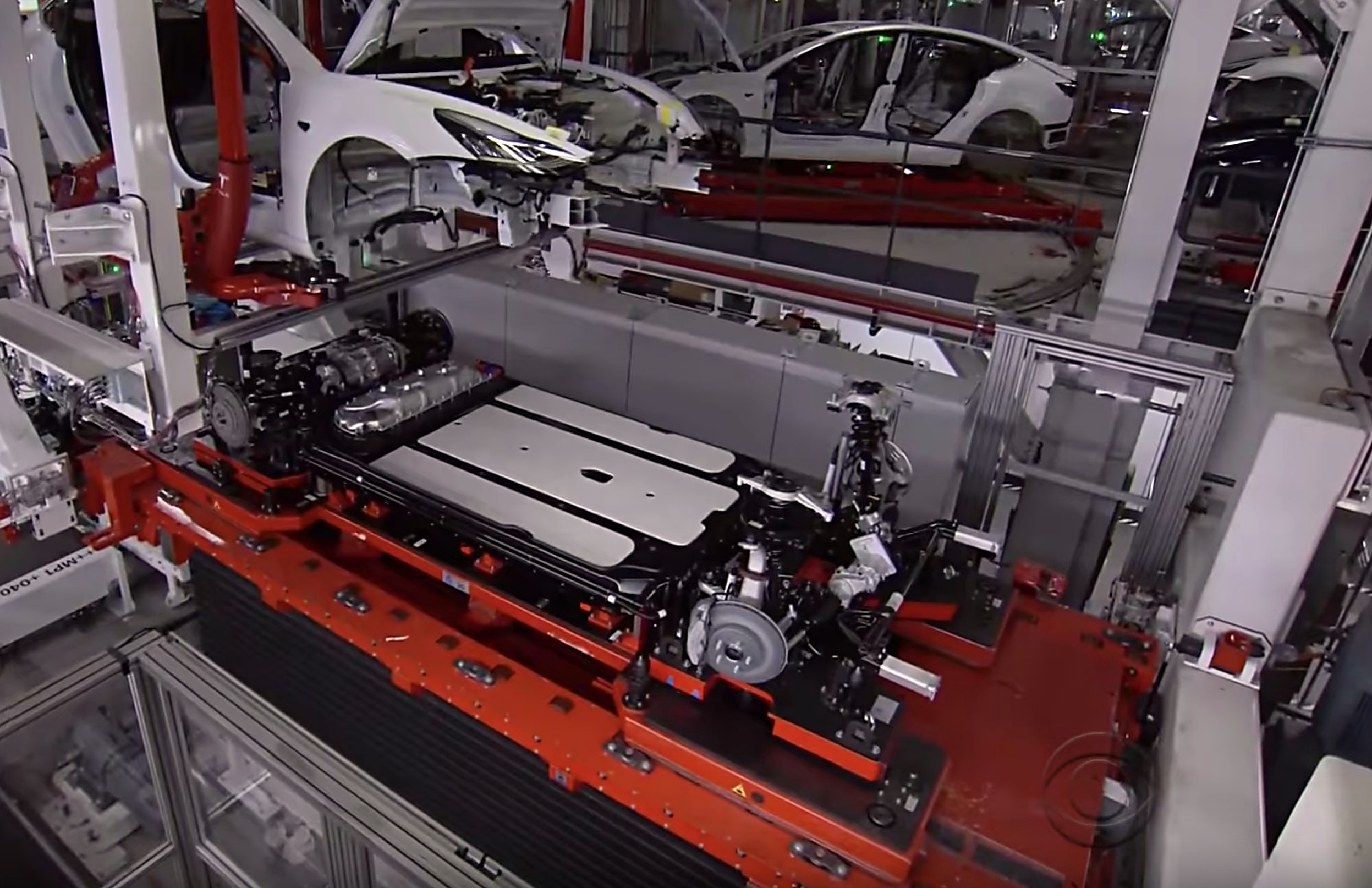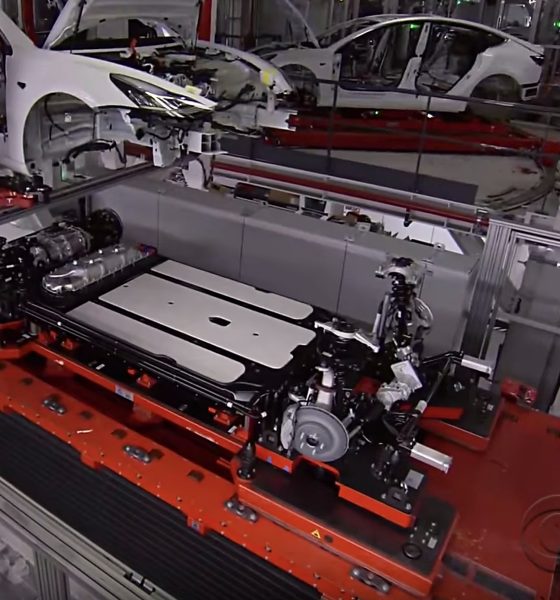

Investor's Corner
Tesla streamlined Model 3 battery pack production time by 96%, says Elon Musk
Tesla CEO Elon Musk stated during Wednesday’s Q1 2018 earnings call that the company has managed to reduce the time it takes to produce a Model 3 battery pack by 94%, from 7 hours to under 17 minutes. According to Musk, addressing the over-generalization of the Model 3’s design, as well as the excessive automation in Gigafactory, proved beneficial to the improvement in the manufacturing rate of the car’s battery packs.
“This still remains to be fixed, but in any case, overgeneralizing the design. For example, the current battery pack has a port for front drive units, which we then put a steel blanking plate on. So essentially, we punched a hole in it and put a blanking plate at the hole. And (we had to) do that for all rear drive unit cars, which is kinda crazy.
“It would have added cost, it would have added a manufacturing step, it would have added a failure mode; and four ports was unnecessary… That’s changed. So, the result was we had a rapid improvement in battery pack production, from taking 7 hrs to make a pack 3 weeks ago to under 17 minutes now. We’re able to also achieve a sustained rate of 3,000 vehicles a week, so we’re actually slightly ahead in battery module and pack production than expected.”
With the optimizations to the line in place, Musk revealed that Tesla is now producing 3,000 battery packs per week at the Nevada Gigafactory, with peak hours of production hitting a rate of 5,000 per week.
“In the last 24 hours at the Gigafactory, we managed to keep a sustained rate of over 3,000 packs per week. We actually reached a peak hour, extrapolated outward would be a rate of over 5,000 cars per week… Every hour is as good as its peak. If you can achieve it even once in an hour, then with continued refinement of the system, and improved operational time of the machinery, you can achieve that sustained rate with more refinement.”
Musk reiterated his previous statement about the company automating too much of its production line. According to Musk, Tesla “went too far and automated some pretty silly things,” including an incredibly complex “fluff machine” that ended up making production complicated.
“One of the things we’ve found is that there are some things that are very well suited to manual operations, and there are some things are very well suited to automated operations. The two should not be confused. We did go too far in the automation front, and automated some pretty silly things.
“One example would be, we have these fiberglass mats on top of the battery pack. They’re basically fluff. We tried to automate the placement and bonding of fluff to the top of the battery pack, which was ridiculous. ‘Flufferbot,’ which was really an incredibly difficult machine to make work. Machines are not good at picking up pieces of fluff. Hands are way better at doing that.
“So we had this super-complicated machine, using a vision system to try and put a piece of fluff on a battery pack. The line kept breaking down because Flufferbot would frequently fail to pick up the fluff, or put it in a random location. So, that was one of the silliest things we’ve found.”
The revelations about the improvements in the pace of Model 3 battery pack production are in line with Elon Musk’s recent statements about relying too much on automation. Musk mentioned this in an interview with Gayle King of CBS This Morning, and later in a tweet, where he coyly stated that humans are “underrated.”
Nevertheless, Tesla pointed to strategic automation as key in its Q1 Update Letter. The company, for one, credits the quality improvements in the Model 3 line to the automation that is involved in manufacturing the vehicles. Tesla expects the Model 3 line to be optimized once more after a planned 10-day shutdown in production during the second quarter. With a hiring ramp underway, Tesla is aiming to adjust overtime hours and staffing levels to meet its production goals even further.
Tesla’s first-quarter earnings for 2018 saw the electric car maker posting $3.4 billion in revenue and beating earnings estimates with a loss of $568 million. Losses per share was listed at -$3.35 per share, lower than Wall Street estimates of -$3.58 per share.

Investor's Corner
Tesla stock closes at all-time high on heels of Robotaxi progress

Tesla stock (NASDAQ: TSLA) closed at an all-time high on Tuesday, jumping over 3 percent during the day and finishing at $489.88.
The price beats the previous record close, which was $479.86.
Shares have had a crazy year, dipping more than 40 percent from the start of the year. The stock then started to recover once again around late April, when its price started to climb back up from the low $200 level.
This week, Tesla started to climb toward its highest levels ever, as it was revealed on Sunday that the company was testing driverless Robotaxis in Austin. The spike in value pushed the company’s valuation to $1.63 trillion.
Tesla Robotaxi goes driverless as Musk confirms Safety Monitor removal testing
It is the seventh-most valuable company on the market currently, trailing Nvidia, Apple, Alphabet (Google), Microsoft, Amazon, and Meta.
Shares closed up $14.57 today, up over 3 percent.
The stock has gone through a lot this year, as previously mentioned. Shares tumbled in Q1 due to CEO Elon Musk’s involvement with the Department of Government Efficiency (DOGE), which pulled his attention away from his companies and left a major overhang on their valuations.
However, things started to rebound halfway through the year, and as the government started to phase out the $7,500 tax credit, demand spiked as consumers tried to take advantage of it.
Q3 deliveries were the highest in company history, and Tesla responded to the loss of the tax credit with the launch of the Model 3 and Model Y Standard.
Additionally, analysts have announced high expectations this week for the company on Wall Street as Robotaxi continues to be the focus. With autonomy within Tesla’s sights, things are moving in the direction of Robotaxi being a major catalyst for growth on the Street in the coming year.
Elon Musk
Tesla needs to come through on this one Robotaxi metric, analyst says
“We think the key focus from here will be how fast Tesla can scale driverless operations (including if Tesla’s approach to software/hardware allows it to scale significantly faster than competitors, as the company has argued), and on profitability.”

Tesla needs to come through on this one Robotaxi metric, Mark Delaney of Goldman Sachs says.
Tesla is in the process of rolling out its Robotaxi platform to areas outside of Austin and the California Bay Area. It has plans to launch in five additional cities, including Houston, Dallas, Miami, Las Vegas, and Phoenix.
However, the company’s expansion is not what the focus needs to be, according to Delaney. It’s the speed of deployment.
The analyst said:
“We think the key focus from here will be how fast Tesla can scale driverless operations (including if Tesla’s approach to software/hardware allows it to scale significantly faster than competitors, as the company has argued), and on profitability.”
Profitability will come as the Robotaxi fleet expands. Making that money will be dependent on when Tesla can initiate rides in more areas, giving more customers access to the program.
There are some additional things that the company needs to make happen ahead of the major Robotaxi expansion, one of those things is launching driverless rides in Austin, the first city in which it launched the program.
This week, Tesla started testing driverless Robotaxi rides in Austin, as two different Model Y units were spotted with no occupants, a huge step in the company’s plans for the ride-sharing platform.
Tesla Robotaxi goes driverless as Musk confirms Safety Monitor removal testing
CEO Elon Musk has been hoping to remove Safety Monitors from Robotaxis in Austin for several months, first mentioning the plan to have them out by the end of 2025 in September. He confirmed on Sunday that Tesla had officially removed vehicle occupants and started testing truly unsupervised rides.
Although Safety Monitors in Austin have been sitting in the passenger’s seat, they have still had the ability to override things in case of an emergency. After all, the ultimate goal was safety and avoiding any accidents or injuries.
Goldman Sachs reiterated its ‘Neutral’ rating and its $400 price target. Delaney said, “Tesla is making progress with its autonomous technology,” and recent developments make it evident that this is true.
Investor's Corner
Tesla gets bold Robotaxi prediction from Wall Street firm
Last week, Andrew Percoco took over Tesla analysis for Morgan Stanley from Adam Jonas, who covered the stock for years. Percoco seems to be less optimistic and bullish on Tesla shares, while still being fair and balanced in his analysis.

Tesla (NASDAQ: TSLA) received a bold Robotaxi prediction from Morgan Stanley, which anticipates a dramatic increase in the size of the company’s autonomous ride-hailing suite in the coming years.
Last week, Andrew Percoco took over Tesla analysis for Morgan Stanley from Adam Jonas, who covered the stock for years. Percoco seems to be less optimistic and bullish on Tesla shares, while still being fair and balanced in his analysis.
Percoco dug into the Robotaxi fleet and its expansion in the coming years in his latest note, released on Tuesday. The firm expects Tesla to increase the Robotaxi fleet size to 1,000 vehicles in 2026. However, that’s small-scale compared to what they expect from Tesla in a decade.
Tesla expands Robotaxi app access once again, this time on a global scale
By 2035, Morgan Stanley believes there will be one million Robotaxis on the road across multiple cities, a major jump and a considerable fleet size. We assume this means the fleet of vehicles Tesla will operate internally, and not including passenger-owned vehicles that could be added through software updates.
He also listed three specific catalysts that investors should pay attention to, as these will represent the company being on track to achieve its Robotaxi dreams:
- Opening Robotaxi to the public without a Safety Monitor. Timing is unclear, but it appears that Tesla is getting closer by the day.
- Improvement in safety metrics without the Safety Monitor. Tesla’s ability to improve its safety metrics as it scales miles driven without the Safety Monitor is imperative as it looks to scale in new states and cities in 2026.
- Cybercab start of production, targeted for April 2026. Tesla’s Cybercab is a purpose-built vehicle (no steering wheel or pedals, only two seats) that is expected to be produced through its state-of-the-art unboxed manufacturing process, offering further cost reductions and thus accelerating adoption over time.
Robotaxi stands to be one of Tesla’s most significant revenue contributors, especially as the company plans to continue expanding its ride-hailing service across the world in the coming years.
Its current deployment strategy is controlled and conservative to avoid any drastic and potentially program-ruining incidents.
So far, the program, which is active in Austin and the California Bay Area, has been widely successful.








